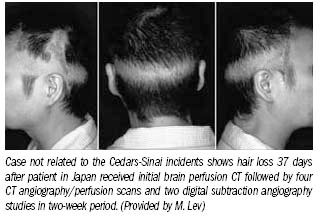- AI
- Molecular Imaging
- CT
- X-Ray
- Ultrasound
- MRI
- Facility Management
- Mammography
Cedars-Sinai accidents stir interest in scanner security
In the aftermath of CT-related radiation accidents at the prestigious Cedars-Sinai Medical Center in Los Angeles, the FDA, healthcare providers, and manufacturers are taking action to avoid suffering through similar situations themselves.
In the aftermath of CT-related radiation accidents at the prestigious Cedars-Sinai Medical Center in Los Angeles, the FDA, healthcare providers, and manufacturers are taking action to avoid suffering through similar situations themselves.
The imaging community was put on its guard in October when the FDA and Cedars-Sinai officials announced that 260 stroke patients had been exposed to eight times the normal radiation from perfusion CT ordered to characterize ischemic stroke. Eighty patients incurred hair loss from the overexposure, and 56 received exposure directly to the lenses of their eyes, elevating their risk of cataracts.
A preliminary investigation determined that modifications to the master CT perfusion protocol responsible for the injuries went unnoticed for 18 months. It was discovered only after a former stroke patient complained about hair loss.
The episode suggested that if such accidents could occur at Cedars-Sinai, they could pop up anywhere.
“Cedars-Sinai is a quality place. It is not a little Podunk hospital where bad things happen,” said Dr. Elliot Fishman, a professor of radiology and oncology at Johns Hopkins University Hospital.
Because of pending litigation, the hospital and GE, maker of the CT equipment implicated in the accidents, declined to comment on the situation, but other groups and individuals chimed in with recommendations.
In a Dec. 7 release, the FDA disclosed that similar problems had been discover-
ed in at least one more hospital and in-volved another CT manufacturer. The federal agency also received reports of possible excess radiation from other states.
The FDA encouraged every facility performing CT imaging to review its CT protocols. Key indices to check include the volume CT dose index and the dose-length product.
Technologists were asked to carefully monitor the dose indices displayed on the control panel before and after scanning. Though settings may be modified to adjust for patient size and weight, displayed values should reasonably correspond to the doses normally associated with the protocol, the FDA said.
“While we do not know yet the full scope of the concern, facilities should take reasonable steps to double-check their approach to CT perfusion studies,” said Dr. Jeffrey Shuren, acting director of the FDA's Center for Devices and Radiological Health.
The American College of Radiology and American Society of Neuroradiology issued a joint statement in October. Among seven recommendations, they suggest the lead radiologist, lead CT technologist, and qualified medical physicist work together to design and review all new or modified protocol settings.
The FDA met with industry executives from the Medical Imaging Technology Alliance (MITA) during the RSNA annual meeting in December. The agency advised manufacturers to review their training for users, reassess information provided to healthcare facilities, and put into place new surveillance systems to identify problems quickly.
Standard equipment features embedded in CT software would also help to reduce risks, Fishman said. Siemens and GE already have password-enacted security systems to limit access to master protocols, reducing the likelihood of accidental changes like that which contributed to the accidents at Cedars-Sinai, but those modules often are not activated, he said.

Fishman also supports electronic “red flag” warnings that would appear on the control monitor whenever a setting would lead to high radiation exposure.
“There need to be some idiot buttons. You need a red light that tells you something is wrong or an alert that asks 'Do you really want to do this?” he said.
The recommended scanning parameters for brain perfusion CT are 80 kVp and about 200 mAs for maximal perfusion signal and minimal radiation dose, according to Dr. Michael Lev, director of emergency neuroradiology at Massachusetts General Hospital.
Vendors are collaborating on an industry-wide initiative through MITA to respond to the Cedars-Sinai incident.
Philips has introduced a password-activated security system for medical personnel specifically designed to write custom CT protocols. Available on new 64-slice scanners, it adds a layer of protection beyond a system-level password that already limits access to scanner operations, said Peter Reimer, vice-president of global marketing for CT.
After Cedars-Sinai's problems came to light, Toshiba America Medical Systems reminded its installed base to use the password security system, which limits the ability to alter master protocols to only designated personnel. Toshiba's default perfusion imaging protocol on the Aquilion One uses a volumetric approach to limit radiation, said Douglas Ryan, senior director of CT business. As do its competitors, Toshiba teaches dose optimization techniques to technologists and physicians.
Default protocols on Philips' CT scanner cannot be modified. Software-based warnings apply to both default and user-designed protocols. The user is warned whenever settings exceed recommended radiation levels. The user must acknowledge the warning before the scanner will allow the procedure to move forward.
Iterative reconstruction technology promises to reduce patient exposure in some cases by up to 80%. GE, Siemens, Philips, and Toshiba all featured iterative reconstruction as either commercial products or works-in-progress at the 2009 RSNA meeting.
Study Reveals Benefits of Photon-Counting CT for Assessing Acute Pulmonary Embolism
April 23rd 2024In comparison to energy-integrating detector CT for the workup of suspected acute pulmonary embolism, the use of photon-counting detector CT reduced radiation dosing by 48 percent, according to newly published research.
The Reading Room: Racial and Ethnic Minorities, Cancer Screenings, and COVID-19
November 3rd 2020In this podcast episode, Dr. Shalom Kalnicki, from Montefiore and Albert Einstein College of Medicine, discusses the disparities minority patients face with cancer screenings and what can be done to increase access during the pandemic.
AI Adjudication Bolsters Chest CT Assessment of Lung Adenocarcinoma
April 11th 2024The inclusion of simulated adjudication for resolving discordant nodule classifications in a deep learning model for assessing lung adenocarcinoma on chest CT resulted in a 12 percent increase in sensitivity rate.
